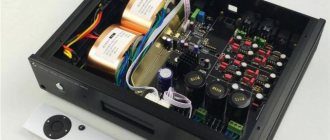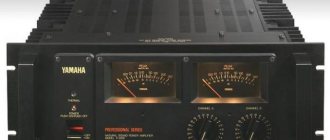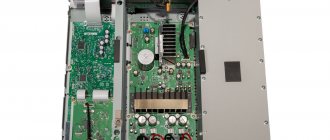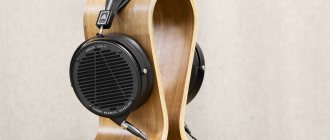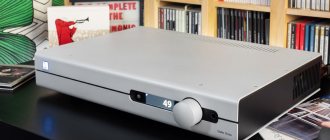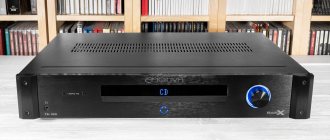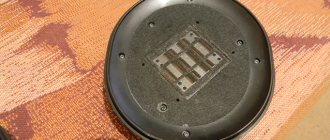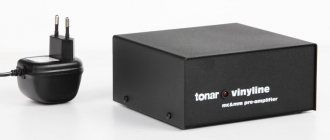Matrix X-Sabre Digital-to-Analog Converter
My first impression of listening to the Matrix X-Sabre can be summed up as follows: clean, well-resolved, yet slightly laid-back with smooth but extended highs, great timbre and a pleasing sense of overall balance. That's the big picture in a nutshell, so don't read any further if you don't want to. Or continue.
Among DACs, there are several archetypes that most users are familiar with. There is an overly slow, warm, cloying type. And then there is the super-detailed, analytical, subtle type. Everyone else falls somewhere between these two, but most lean more towards the first or second type. A very small number of devices are completely in the middle, usually in the upper price segment. Not to mention the fact that most users are constantly arguing where this golden mean lies.
It can't be argued that the Matrix X-Sabre is right in the middle. To my ears, he is closer to the so-called “musical” type than to the drier, analytical type. Fortunately, it does not have many of the shortcomings of its brothers: it is not slow, it is not at all rounded, it does not have mawkish bass and it does not add excessive color to the sound. It is also devoid of many of the shortcomings of the analytical type: it has no roughness and coarseness at the top and not the slightest lightness at the bottom. Got the best of both? Not really. Some DACs are better at extracting detail, some have more textured bass, others have a cleaner, more transparent sound. But overall I'm very pleased with the X-Sabre. $1100 is not such a small amount, but by and large, this cannot be considered an excessively high price for a DAC. Matrix made some compromises, but the priorities were right.
These last few lines explain why I love the X-Sabre so much. While researching competing models in the $800-$1500 price segment, I found only one DAC that beats the X-Sabre in some respects. And yet very few of them are able to generally sound as good in all respects. Many analogies can be made here, such as a well-balanced athlete who may not be seen in a Nike commercial, but who has had a long and successful career, has earned millions of dollars and is deeply respected by competitors and fans. Or how about your favorite neighborhood restaurant with a very varied menu? It doesn't specialize in any one area, so you can find the best steak, the best pasta, the best fried chicken... but only in a highly specialized establishment that doesn't have half the selection of food that your favorite place has. I could go on, but I hope you get the point: overall, the X-Sabre is really good, if not the best in any given aspect. Here are a few other points worth mentioning: · Impressive sound stage. It has a pleasant sense of openness that is so difficult to capture even on many expensive models. If there was one particular area where the X-Sabre excels, it would be the soundstage. · Warmth. As I already said, the X-Sabre belongs to the type with a warm and smooth sound. It's not a loaded and warm tube NOS sound or anything like that, but it helps to sense the "zest" hidden in some of the recordings (in a good way). I don't think it lacks the punch of good recordings, but average quality recordings with a rough sound take on a certain softness. I noticed a slight brightness in the highs during the first hours of listening, but then this sensation went away. Perhaps, by and large, the brightness never completely disappeared (if you compare, for example, with Resonessence Labs Invicta), but now, after several hundred hours of listening, it does not bother me. · Differences in input connectors. I mainly used a USB connection to my laptop. The sound was very good. Improving the sound using the USB-SPDIF converter took a lot of effort: the Stello U3 sounded worse, producing a slightly harsher sound, which confused me a little. The sound wasn't terrible, but it lost some of its charm compared to the USB port. Resonessence Concero as a digital-to-digital converter is very difficult to distinguish from its native USB input, at least in standard mode. When using Resonessence's proprietary upsampling filters (IIR or apodizing filter), subtle changes in the character of the sound are felt. I especially like the minimum-phase IIR filter in this regard, but it doesn't justify purchasing the $599 Concero as a must-have add-on. I then thoroughly tested the Audiophilleo AP1 with the PurePower power supply. This combination has significantly raised the bar in terms of transparency, imaging, and fluidity in the mids and upper mids. I liked it, but when it came time to return to my native USB, I did not experience any internal protest. Finally, I tried my Cambridge Audio 740C via coax as transport. The X-Sabre sounded sharper again, just like with the Stello U3. In the grand scheme of things, the sound wasn't that bad, and if I had no other choice, I would still like this DAC... but I like it much better over USB. I didn't have a chance to test my JF digital music server, which has less jitter on the SPDIF output. It might have sounded closer to USB, but I was too lazy to move it from the living room system. · I didn't notice any difference between the RCA and XLR connections, other than the higher voltage on the XLR output that I mentioned earlier. There may still be some minor difference, but if so, it does not make a significant difference. I spent a lot of time listening to some extraordinary DSD recordings. The DSD demo albums from Opus3 Records are definitely worth purchasing if you need demo material. $12.99 for DSD128 and just $9.99 for DSD64 is a small sum compared to the inflated prices of some high-res albums. I'd still be delighted with Eric Bibb's "Where the Green Grass Grows" even if I was listening to a low bitrate mp3... but the DSD version is probably one of the most realistic recordings I've ever heard ever heard anywhere. I spent most of my time listening to the DSD128 recording, and why not? To be fair, the DSD64 version sounded just as great, as far as I can be sure I could reliably differentiate between the two. But I didn’t really try, so that’s a topic for another review. Both are distinguished by their rich timbre, natural airiness, impeccable imagery (name me another audiophile cliché), and to a very high degree of probability this quality is present in this track. I was also extremely impressed by the vocal ensemble of Erik Westberg and Matthias Wager's Nun kommt der Heiden Heiland, which features simply stunning organ that gets to the heart of the matter. The lows in this track perfectly reveal the difference between high-end headphones (LCD-2, 8.A, SR-007, JH13) and just “pretty good” ones (W1000X, HD650, DT880, etc.). DXD tracks keep up with DSD and sound great too. I have Quiet Winter Night by Hoff Ensemble, which, like many other recent high-definition releases, was originally recorded in DXD at 24-bit/352.8 kHz and later converted to DSD and PCM. I find it hard to believe that DSD could be any better, because the DXD release is already great. I got this album as a promotional sample - one of the best things about being a "real" audio journalist - but I only have this one version. If I had to buy it, I'm not sure I'd want to pay almost double the price for DXD compared to the good old 24/96 FLAC version. And yet, maybe I would have paid if the difference had been noticeable. This opens up an interesting discussion about why there is such a price differential for download versions, but I won't go into that here. What about high definition PCM? PCM recordings still sound great on the X-Sabre. My usual reference set all sounded great - Conga Kings, CBW's Traffic, Wilson Pickett, Norah Jones... Now we come to discussing the "boring" standard CD quality material that still dominates our libraries. Should this quality be considered limited and difficult to listen to after all these amazing high definition recordings? Yes and no. By their very nature, high-definition releases are some of the best in any format. Yes, sometimes there are unsuccessful resampling or some popular modern releases that make no sense to buy in high resolution due to the inherently low dynamic range. But these are exceptions. Much of the high-resolution material also sounds great on standard CD. However, things that were only released on CD can sound very mediocre, and sometimes downright terrible. For example, Rush or the Red Hot Chili Peppers are particularly annoying, and while the music itself is good, the same cannot be said for the quality of the recording. And yet there are many counterexamples: listen to Steve Hoffman's restoration of Metallica, any Hiromi or Yo-Yo Ma album, any Reference Recordings record, most Peter Gabriel or Genesis albums, any Miles Davis, Otis Redding, Alison track Krauss & or Bill Evans... continue on your own. Material on a CD can sound either downright bad or really, really good, and the blame shouldn't be placed entirely on the format. The X-Sabre handles good material very well, and thanks to its fairly smooth sound, it handles “bad” material better than most. What I'm trying to say is that great recordings come in many different formats, and the X-Sabre can play them all well.
DAC Saber 9038 PRO vs PCM 1796. Switching test, final cure
Hello
This is my last post, I have finally recovered from audio disease, which is what I wish for everyone. So…
I had a DAC with two trans on a Saber 9038 PRO (from mshow MUSES8920 + AD797 + Amanero USB). I also have an Arcam irDAC DAC on PCM1796, I always considered it a very good device for the money, quite a rare guest on the secondary market.
When I purchased the Saber, the first thing that struck my ears was the transparency, detail, more collected bass, I was firmly convinced that this device was head and shoulders above my Arcam, but also when switching I noticed that the Arcam was playing a little louder.
One day I came up with the idea of doing a test with switching: two laptops, two DACs, plugging interconnects into different inputs on the amplifier, launching the same composition from both hands in FUBAR on different laptops at the same instant. And most importantly: using a sound level meter (you can use it by ear, I definitely guessed by ear) the same volume level of the DACs. Next, from the remote control, while listening, click the input selector, thus switching. to different DACs.
What did I hear? NOTHING, the sound was identical throughout!
The wife also didn’t hear anything, then a friend came. He is more trained in terms of hearing (the genres of music that we listen to vary greatly, this is also a plus in this case, IMHO). He started to switch, but also did not hear anything.
I thought there was a catch somewhere and turned off Saber, but there was no catch, I turned off Saber, and when I switched to it the sound disappeared)))
In general, maybe my experience of such tests will help someone in terms of curing audio disease. I think, starting from some not very high price point, all DACs are identical, only the volume level of the source affects the perception. Of all the components of the audio path, the only question that remained open for me in the context of audio illness was the question of sources, now I have closed it. Moreover, I previously used a battery-powered Arcam, but after testing I abandoned it - there is no difference! Although before the tests it seemed that there was.
Since I haven’t been paying attention for a long time to how many details were put inside the component (you can compare the Sybra and the Arches by the insides yourself), I left Arcam for myself. It has good drivers, you can switch tracks from the remote control in Fubar, for example. Very comfortably.
PS For me, there is no mystery in hi-fi, there is ignorance and marketing. Good luck to all.
PPS If you live in a room of normal size (mine is 18.5 sq.m.), I recommend investing primarily in the acoustics and acoustic design of the room. All other boxes with silicon are secondary and will not provide a noticeable increase in sound.
Tests were carried out on Dynaudio Evoke 20 acoustics.
